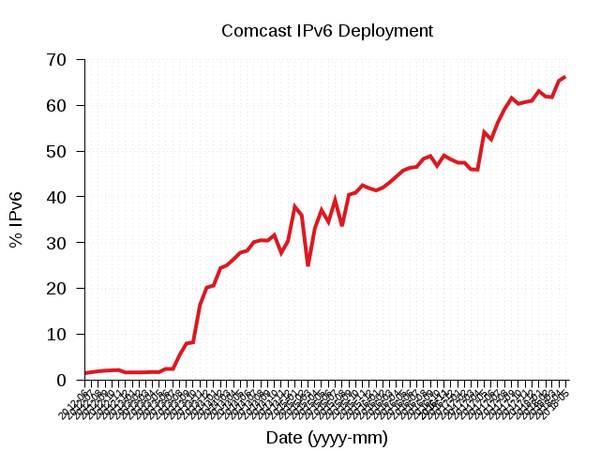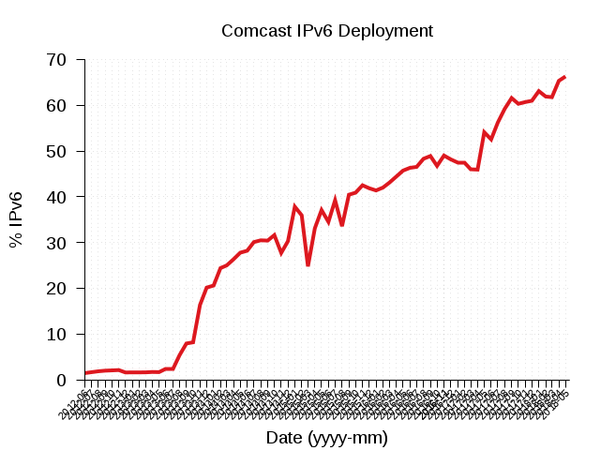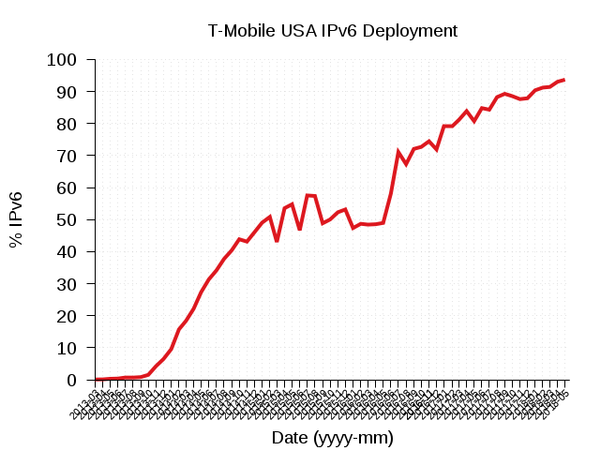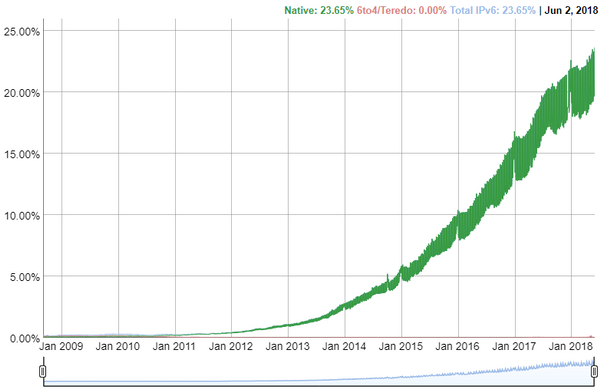June 6, 2018 marks the 6-year anniversary of what is known as World IPv6 Launch. This event, which was coordinated by the Internet Society (ISOC), took place on June 6, 2012. On that date, many of the large content providers permanently enabled IPv6 on their primary web sites. Content providers such as Facebook, Google, Yahoo, Akamai, and Limelight Networks promised to turn on IPv6 and leave it turned on. Internet service providers such as Time Warner Cable (now Charter Communications), Comcast, AT&T, Free Telecom, Internode, KDDI, and XS4ALL also promised to enable IPv6 service for over 1% of their subscribers. Network equipment companies such as Cisco, Juniper, and D-Link promised to have IPv6-enabled devices for providers and subscribers and rapidly troubleshoot any problems encountered.
World IPv6 Launch was preceded by World IPv6 Day. World IPv6 Day was on June 8, 2011 and was a single 24-hour trial where content providers tried to ascertain the percentage of Internet users who may have trouble connecting to their sites using IPv6. They accomplished this by enabling IPv6 for their primary web domains (e.g., www.google.com and www.yahoo.com). There was concern about problems end-users might experience when their devices were presented with a choice of Internet protocols and there was much preparing to avoid these issues. Though there was some fear among the IT community over World IPv6 day, it ended up being a bit more like an uneventful Y2K. This gave confidence to the content providers that IPv6 was not going to adversely impact their end-user’s experience.
The concern about “IPv6 Brokenness” lead to the development of Happy Eyeballs (RFC 6555) which makes TCP/IP stacks in hosts more aggressive about making simultaneous IPv4 and IPv6 connections and then choosing IPv6 if they are connecting equivalently fast. Prior to Happy Eyeballs, TCP/IP stacks would attempt to connect to dual-protocol destinations using IPv6 first then fall back to trying IPv4 if IPv6 didn’t connect. This broken IPv6 connectivity led an extremely small population of end-users to believe the site they were trying to reach was down because of the potentially long duration for their web browsers and OSs to eventually connect with IPv4. Content providers worried that such a conclusion might cause damage to their brands and they hesitated to unilaterally enable IPv6 for their primary web domains.
These connection optimization methods are now implemented into virtually all mobile device operating systems and most web browsers. As a result, when end-users are connected to a network that offers them the opportunity to use either IPv4 or IPv6, they are assured that they will be able to reliably connect. As a result, most mobile device users are using IPv6 and they don’t even realize it. That is ideal, because we, in the IT community, don’t want to have to explain to our family members what an IPv6 address is while trying to enjoy a leisurely summer barbeque.
Now 6 years later, there is life after World IPv6 Launch, and we have witnessed the sustained growth of IPv6 adoption across the Internet. There are many sites that collect and display statistics and offer their observations about IPv6 as well as provide comparisons to IPv4. However, the key location for information about World IPv6 Launch success is the World IPv6 Launch Measurements site itself. This ISOC-supported site collects measurements from a variety of sources and then produces graphs of the percentage of subscribers or users an organization has who are actively using IPv6. Statistics are collected from the ISPs who participated in World IPv6 Launch six years ago as well as data from Akamai, APNIC, Facebook and Google. Akamai also has their own IPv6 Adoption Visualization site that shows IPv6 usage for countries or specific networks.
Our friend and Infoblox IPv6 COE colleague Tom Coffeen (@ipv6tom) has also put together two articles about the valuable websites showing IPv6 adoption (Part 1, Part 2) and providing guidance for organizations looking to deploy IPv6.
Another useful report that synthesizes all of the effort put forth toward deploying IPv6 and measurements of the resulting increases in IPv6 deployment on the Internet is the HexaBuild IPv6 Adoption Report. This report, and its accompanying infographic, shows many graphs and statistics of IPv6 adoption showing significant progress deploying IPv6 by mobile carriers, broadband Internet providers, backbone ISPs, and large content providers. This report also discusses how many commercial enterprises have yet to put forth any real effort toward IPv6 implementation on their Internet perimeter or interior networks.
Examples of some of the successful IPv6 deployments since World IPv6 Launch can be seen in the World IPv6 Launch graphs for Comcast and T-Mobile.
These simple graphs perhaps conceal the tremendous amount of hard work by many individuals to reach these levels of IPv6 traffic. These service providers had a massive amount of equipment to upgrade and configure to establish a robust IPv6-enabled backbone network and Internet peering. These companies also had to upgrade their subscriber access networks. In the case of Comcast this required the upgrading of many CMTSs, while in the case of T-Mobile it required upgrades to their 4G wireless access systems. These companies also needed to help their subscribers upgrade their CPE devices. For Comcast this meant getting their subscribers to move to DOCSIS 3.0/3.1 modems and upgrade their home routers, set-top-boxes, etc. For T-Mobile, that meant getting their subscribers to use smartphones with dual-protocol operating systems (like Apple iOS and Android) while also comprehensively testing the IPv6 capabilities of the phones. Congratulations to Comcast and T-Mobile for their outstanding achievements!
The graph that is shown the most to demonstrate the tremendous adoption of IPv6 is the Google IPv6 Statistics page. Google has a global perspective of the whole Internet using both IPv4 and IPv6. They are well-positioned to observe IPv6 adoption around the globe. The graph below shows significant progress in IPv6 global adoption in the 6 most recent years since World IPv6 Launch back in 2012.
Now we might ask ourselves what comes next for IPv6? It sure seems like there has been a tremendous amount of success among the service providers, content providers, and mobile device manufacturers and mobile app developers. It is difficult to see how T-Mobile can make any more progress unless they start to proactively eliminate all their subscribers clam-shell Symbian OS “burner phones” used by luddites, privacy wonks, or malfeasant characters.
We can expect that the world’s networks will progress along the adoption curve and IPv6 will become the majority of overall Internet traffic. If your organization has yet to start to plan for implementing IPv6, there is no time like the present! There is still quite a bit of work to do, especially when it comes to enterprise networks. Most of those organizations do not have IPv6 enabled internally across their internal networks and out to their access networks. Therefore, their end-users likely have IPv6 Internet connectivity on their personal mobile devices and at their homes, but not at work. For enterprises, the priority is to enable dual-protocol Internet connectivity for their end-users by enabling it on their wired and wireless a…. Enterprises can follow well-established guidance for deploying IPv6 across their environments.
We can expect that in the coming years more environments will progress to only using IPv6 and won’t need to use IPv4 (other than to connect to legacy Internet devices). For example, content providers could run IPv6-only entirely in their data centers and expose only a single IPv4 Virtual IP (VIP) on the Internet-side of their application load balancer to preserve reachability for legacy IPv4 users. Some of the first organizations that might make the leap to IPv6-only could be T-Mobile, LinkedIn, Facebook, Cisco, and Microsoft. Each of these companies have spoken publicly about their plans to go IPv6-only and have already done so in portions of their networks.
In a couple of years, we may witness the cross-over point where IPv6 Internet traffic outweighs legacy IPv4 traffic. IPv6 traffic has been shown to be growing exponentially and is starting to have an effect on flattening out IPv4 growth. In a couple of years from now we will see a point where IPv6 traffic volumes overtake IPv4 traffic volumes just like what LinkedIn experienced last year when they announced they crossed that tipping point.
Perhaps the bigger question is, in another 6 years, will we still be talking about the need to adopt IPv6. By then IPv6 may virtually replace all IPv4 and be, simply, referred to as the Internet Protocol?
This post originally appeared on Infoblox Community at https://community.infoblox.com/t5/IPv6-CoE-Blog/Celebrating-the-Sixth-Year-Anniversary-of-World-IPv6-Launch/ba-p/13556.
Scott Hogg is the Chief Technical Officer (CTO) of GTRI, now Zivaro.



